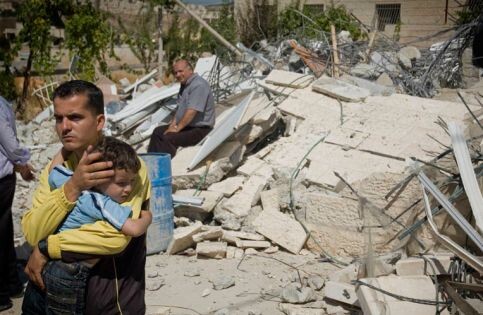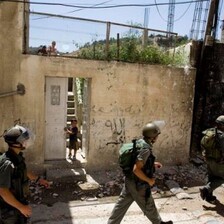The Electronic Intifada 2 November 2010

A Palestinian home demolished in Beit Hanina, occupied East Jerusalem, July 2009. (Silan Dallal/ActiveStills)
Bulldozers, backed by Israeli soldiers and police forces, razed a Bedouin Palestinian encampment in Isawiya, a village northeast of Jerusalem on Wednesday, 27 October. Israeli forces destroyed tents and other structures that were home to six families, according to Ma’an News Agency (“Israel Razes Bedouin Camp,” 27 October 2010).
“Hani al-Eisaway of the Isawiya Land Defense committee said that the Israeli [forces] bulldozed more than 50 dunams (12.5 acres) of land,” Ma’an reported. The encampment was close to the Israeli settlement of Maale Adumim.
Israel has designated the area where the homes were razed as the “E1 zone,” an area in the occupied West Bank and centered in East Jerusalem, where Maale Adumim and other nearby settlement blocs are being planned to connect together.
The massive settlement project would incorporate Givat Zeev and Ariel settlement blocs in the north, Maale Adumim in the center, and Gush Etzion in the south. The plan would also stretch east, connecting to settlements in the West Bank’s Jordan Valley — which Israel has designated a closed military zone, making it off-limits to most Palestinians.
All of Israel’s settlements in the West Bank, including East Jerusalem are illegal under international law and violate several United Nations resolutions. There are currently more than half a million Israelis living in such illegal settlements.
Demolition orders issued in East Jerusalem
Elsewhere in East Jerusalem, protests broke out in the Old City on 25 October after Israeli police handed out 231 demolition orders to Palestinians in Silwan, Shufat, Beit Hanina, Isawiya, Wadi al-Dam and the al-Ras area in Wadi al-Joz, and other neighborhoods across the city, Bethlehem-based International Middle East Media Center reported (“Israel Hands 231 Orders Targeting Arab Homes In Jerusalem,” 26 October 2010).
Israeli police posted notices on the doors of five homes in the Palestinian neighborhood of al-Bustan in Silwan. The notices stated that the houses are “illegal” and therefore could face demolition, promting protests by residents, Ma’an reported. The head of the local popular committee, Fakhri Abu Diab, said “a large force of Israeli border guards ransacked the area, using homes as vantage points to fire tear-gas canisters, stun-grenades and rubber bullets ‘in all directions’ ” when the protests broke out (““Israeli ministers back new Jerusalem bill,” 24 October 2010).
Many Palestinian homes in Silwan have been demolished and more more are under regular threat as the neighborhood has been a target by the Israeli-controlled Jerusalem municipality. The Israeli government intends to destroy dozens of houses and turn the area into a Jewish historical theme park which would incorporate Jewish-only settlement housing units. Israeli settlers, police and armed forces frequently attack Palestinians in Silwan, prompting clashes and regular protests, while settler takeovers of Palestinian homes continue apace (“Home demolitions, arrest raids as Israel implements Jerusalem ‘Master Plan’,” 2 July 2010).
According to Israeli human rights group B’Tselem, Palestinians in occupied East Jerusalem are faced with discriminatory housing and building policies, forcing residents to build homes without obtaining building permits, thereby designating the homes as “illegal” and subject to demolition. “The Jerusalem Municipality enforces the building laws on Palestinians much more stringently than on the Jewish population, even though the number of violations is much higher in the Jewish neighborhoods,” states B’Tselem (“East Jerusalem: Policy of discrimination in planning, building and land expropriation”).
According to an August report by Human Rights Watch (HRW), demolitions in East Jerusalem have seen a significant spike in 2010. While Israel continues to demolish more Palestinian homes, “it continues to subsidize the Jewish settlements nearby,” stated Sarah Leah Whitson, Middle East director of HRW (“Israel: New Peak in Arbitrary Razing of Palestinian Homes,” 19 August 2010).
The Israeli government and the municipal authorities have allocated “only 13 percent of East Jerusalem for Palestinian construction, compared with 35 percent for Israeli settlements,” HRW states in its report. “While Israel has built 50,000 housing units for Jewish settlers in East Jerusalem, it has built virtually none for Palestinians, according to Israeli nongovernmental organizations.”
Settlement-building increases four-fold
Israeli daily Haaretz reported on 15 October that 240 building plans were approved by the Israeli housing ministry for units in Ramot and Pisgat Zeev, settlements in northeastern Jerusalem (“Netanyahu approves tenders for 238 homes east of Green Line,” 15 October 2010).
Illegal settlement construction in the occupied West Bank, including East Jerusalem has currently increased up to four-fold that of the estimated rate before the so-called settlement moratorium began in December 2009, according to Israeli settlement watchdog group Peace Now (“Settlers confirm work has begun on up to 600 homes,” Associated Press, 25 October 2010). In the same report, Peace Now added that 600 settlement housing units are currently under construction following the end of the moratorium on 27 September.
Additionally, inside Israel itself, the Palestine News Network reported that several Palestinian-owned homes were demolished in the city of Lydd, near Tel Aviv (“Five Demolition Orders Given to Jerusalem Residents, Two Homes Leveled In Lod,” 26 October 2010).
“Before demolition, soldiers arrested two family members for trying to stop the bulldozers,” PNN reported. “A state spokesman said the homes were built without permission.”


